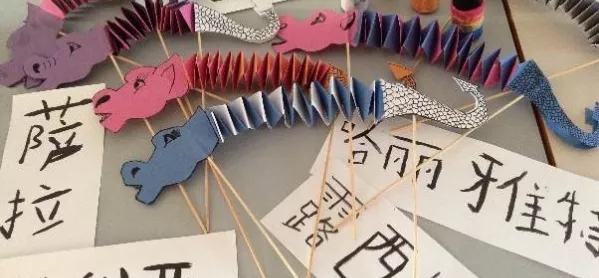Want to introduce Mandarin to your school? Here’s how

We’ve all heard the negative news about the decline in modern foreign languages in schools. The traditional languages of French, German and Spanish have seen a continued fall in popularity at A level, fewer students are sitting French and German GCSEs than just a few years ago and language exchanges and trips abroad are in decline, although efforts are being made to stem this.
But amid this rather bleak landscape, there is a bright spot: Mandarin Chinese. Entries at GCSE and A level are growing across the country, and since its introduction in our school in September 2017, Mandarin Chinese has been a huge success. So how can you introduce it yourself? Here are our tips:
Get support from leadership
Introducing any new subject requires senior leadership support but bringing in an unfamiliar one such as Chinese can raise a lot of questions. Make sure you have a clear rationale as to why you are introducing the language; this will help a great deal as you start to make decisions that affect different areas of the school.
Then thrash out the detail at SLT meetings, working through your plans not just for the first year but the longer term, too. You need to be able to answer questions about who will study Chinese, what they will cover at key stage 3, how they will be assessed, how many teaching hours they will have and what kind of progression you will offer from GCSE to A level.
Then you’ll need the support of governors. Curriculum changes always have staffing and cost implications, but with the backing of your senior team and planning in place, governors are likely to support the move as it adds to the school’s appeal for prospective pupils and parents.
More on this: How to set your pupils on the path towards fluency in Mandarin
Background: Seven reasons to teach Mandarin
Read more: Pupils learn Mandarin to prepare for Brexit
Recruit the right staff
This is both obvious and easier than you might think. Increasing numbers of students are coming through initial teacher training courses in Mandarin - at UCL Institute of Education and Manchester Metropolitan University, for example. There are also native speakers in communities across the UK (even in the northern outpost where we are based, we’ve been surprised at the number of people who have contacted us about teaching Chinese).
Another option is to take on a Hanban teacher; these are highly skilled educators seconded to the UK from regular teaching positions in schools in China. Hanban teachers are able to join staff in your school to work as language teaching assistants for up to two years. You could also supplement your Chinese teaching team through the British Council’s Chinese Language Assistant scheme (which is how our current Mandarin teacher started out, as a visiting language assistant from Beijing).
Think big but start small
Our introduction of Chinese coincided with the development of the Department for Education-supported Mandarin Excellence Programme (MEP), which aims to educate 5,000 young people to a high degree of fluency in Mandarin by 2020. We knew our students and parents would find this appealing but we were amazed at the positive response when we wrote to our prospective students to gauge interest from the incoming Year 7: more than half the year group wanted to be on the MEP.
Nonetheless, we adopted a cautious approach, selecting just one form (of a six-form entry) to study Mandarin via the MEP. This has enabled us to focus our efforts on this group and better monitor their progress. This meant that we offered Mandarin lessons only in Year 7 in the first year but, as the cohorts move through school, Mandarin continues to grow. From September, we will have 12 lessons across Year 7 to 9 and eventually a class of Chinese in each year group each studying towards doing GCSE Chinese in Year 11. And “it doesn’t matter how slowly you go, so long as you don’t stop”; not my words, but those of Confucius, whose name is also carried by the Confucius Institute at the Institute of Education (which, incidentally, is a great source of support in introducing and expanding Chinese provision).
Embrace enthusiasm
You will probably find that many people in your school are interested in Mandarin and Chinese culture and thus there are many ways to link the work you are doing in Chinese with activities and learning in other subjects. Our students have had cross-curricular learning experiences using Chinese and art skills to make and decorate artefacts including dragon puppets, Chinese masks and traditional teacups. They also made some very tasty dumplings in food tech. There are links with almost every subject; the opportunities are only limited by your imagination.
Build education networks
Much of what we have been able to develop is thanks to work with the wider Mandarin education community. An event for northern MEP schools at the University of Leeds gave different schools teaching Mandarin the opportunity to come together, establish new ties and share ideas. Through the MEP, we have had the opportunity to visit other schools and see how they deliver Mandarin. There is also an active online community, with great opportunities to share resources (the Institute of Education at UCL has developed excellent schemes of work, lesson plans, PowerPoints and home-learning tasks, and there are resources from Confucius Institutes and Hanban, as well as what’s available on Chinese social media such as Weibo).
Celebrate your successes
Introducing Mandarin is exciting, and it’s something you should be proud to shout about on your website, social media or in the local press. It’s still a relatively novel and niche undertaking, so use that to your advantage to build a positive narrative around what you’re doing, while watching your school go from strength to strength.
Jonathan Brownlie is deputy headteacher at The Crossley Heath School in Halifax
